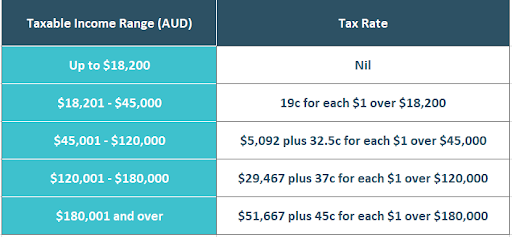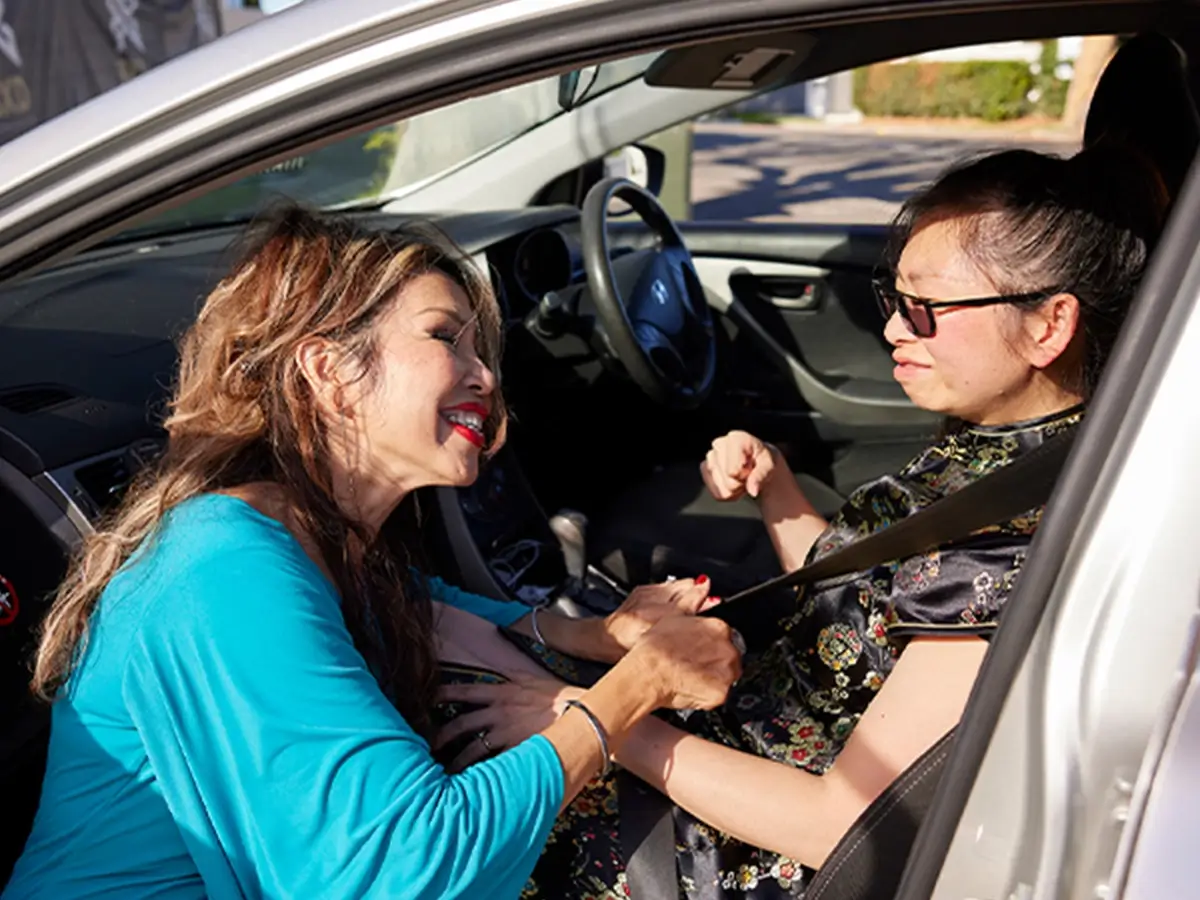This article was written by Tax Accountant and YOUtax director, Emma Baxter. Advice is general in nature.
As an independent support worker trading under your own ABN as a sole trader business, your tax matters are a bit more complicated than a regular employee.
Here are some of the ATO rules you need to know to tackle the tax and compliance obligations when lodging your income tax return.
Understanding how much tax you need to pay
Unlike employees, where your employer will report your income and pay your tax to the ATO, ABN Sole traders are responsible for reporting their own income and paying their tax to the ATO.
In Australia we have what is called a progressive tax rate system. This means that when your income increases, your tax rate may also increase or progress to a higher tax rate. Understanding these tax rate thresholds will help you to plan for how much tax to save, to then pay the ATO.
Below are the income thresholds and the rates of tax you will pay. You must also remember to add a 2% Medicare levy to your tax bill this is required by all Australian resident tax payers.


Example
If in the 2023-2024 tax year you earned $60,000, you will need to pay $5,092 + 32.5 cents for every $1 you earn over $45,000. With a $60,000 salary, you earn $15,000 more than $45,000. This means you’d pay $5,092 + 32.5% of $15,000, which is $5,092 + $4,875, so the tax for your income would be $9,967.
However, this is not the total amount you would pay to the ATO. For the 2023-2024 financial year, you’d pay $9,967 of tax, plus $1,200 Medicare levy, so your total tax for the year would be $11,167.
If you want to figure out how much of your salary goes towards tax, divide your total tax by your salary and multiply by 100. Having this percentage will make it easier for you to put aside money for tax time.
Using the above example, 11,167 ÷ 60,000 x 100 = 18.6%. This means you would need to save $18.60 for every $100 you earn.
Calculating tax
Tax can get harder to calculate if your income is irregular. You may be a new independent support worker and unsure of how fast your client base will grow, or you may have a part-time job, or receive Centrelink payments. All these income sources must be considered when calculating how much Income Tax and Medicare levy you need to put aside.
It’s important you stay up to date with all of your invoices and income sources throughout the financial year. By doing this, you can keep track of, and if or when, you go into the next tax rate threshold, so you can start putting aside more tax. It is good practice to keep a separate bank account for tax.
Utilising Mable tools like Tax & super sync can help minimise the amount of business admin you need to do, as you can set the amount of tax contributions to your nominated bank account.
If you need further assistance, a tax agent will be able to help you calculate your effective tax rate to ensure you are saving the correct amount for tax throughout the year.
Why do I have to make PAYG Instalments to the ATO?
PAYG Instalments are pay as you go tax instalments, and represent a part payment or prepayment of tax made to the ATO throughout the year.
You are usually to report and pay your tax every 3 months (quarterly) to the ATO.
You can voluntarily enter into the ATO’s PAYG Instalment system so you do not have a large tax bill at the end of the year. Or, you may be automatically entered into this system by the ATO as a result of a payable tax amount that is above a certain threshold from your previous years tax return.
If the instalments assessed by the ATO are too high and do not reflect your income earnings for the specified period, you can vary your instalment amount before the due date, or when the next 3 month instalment is raised.
PAYG Instalment payment dates for a standard income year are as follows:
- Quarter 1 (July–September): Due by 28 October
- Quarter 2 (October–December): Due by 28 February
- Quarter 3 (January–March): Due by 28 April
- Quarter 4 (April–June): Due by 28 July
Knowing what you can and can’t claim
As an independent support worker you may incur business expenses related to the work you perform. Your business expenses reduce the total income you are required to pay tax on, and therefore can reduce your tax bill at the end of the financial year.
However, before you can claim an expense you must first check if it is a tax deductible expense. The ATO has many rules, and different methods as to how an expense can be claimed, and occupational guides that help us understand if an expense is deductible for your industry.
The ATO’s 3 Golden Rules that you must follow to ensure you can claim an expense in your tax return:
- You must have spent the money yourself and not have been reimbursed by a client or employer. E.g. An entry ticket for a client, who paid you back.
- It must be directly related to earning your income and the expense must be apportioned to your work use only if used both personally and for work purposes. E.g. Car expenses and mobile phone expenses.
- You must have a record to prove it e.g. receipts, invoices or logs.
Apportionment of an item you use both personally and for work requires you to track the personal and work use so that only the work use can be claimed.
Example 1
Depending on the type of support you provide, you may be required to have completed your First Aid or CPR Training. This training expense is directly related to a qualification required to care for your clients and in turn earn your income, and is therefore tax deductible.
Example 2
You may be required to drive your client to a medical appointment (as per your written agreement) and on the way home you stop for a coffee or some lunch. The purchase and personal consumption of food for you or your client is not tax deductible because it is not an expense directly related to task or work set out in your written agreement.
Example 3
Using the above example, the car expenses you incurred in picking up your client and driving them to and from their appointment (including any parking or toll costs you incurred) are a tax deductible expense, as they were incurred whilst earning your income.
Example 4
You provide assistance with daily living and perform cleaning tasks for your client under their NDIS plan and as outlined in your written agreement. You provide the cleaning products and bring your own vacuum cleaner to your clients home. You have a separate vacuum for which you clean your personal home. All cleaning products, equipment and the vacuum cleaner are a tax deductible expense. If you used the same vacuum to clean your personal home then you would be required to apportion the expense to work use only.
Other common expenses may include PPE or consumables like gloves, masks, sanitiser or tissues.
If you are unsure if an expense is deductible, ensure you follow the ATO’s 3 Golden Rules or check with a qualified tax adviser.
Understanding which car expense method is best for you
Generally, your vehicle will be used for work and personal tasks. Following the ATO’s 3 Golden Rules, expenses related to an asset that is used for work and personal tasks must be apportioned to claim the work use only as a tax expense.
In most cases, as an independent support worker, car expenses are likely to be the highest claimable expense you will have. Depending on the method you use, this can significantly reduce your tax payable.
However, without correctly tracking your car travel or saving your receipts, you could be missing out on substantial tax deductions.
There are 2 main methods that the ATO uses to help value your car expenses in order for them to be claimed in your tax return. The cents per kilometre method (CPKM) or the logbook method.
Logbook method
This method involves making a claim that is a better representation of your actual vehicle expenses by tracking the business use of your vehicle over a set period to establish a business-use percentage, which can then be applied to your cars actual expenses to determine the deductible amount.
Here’s how it works:
1. Start a logbook
2. Record your details for each trip
You are required to record every trip made with your car during the logbook period. You will need to record the following:
- Date of the journey
- Odometer readings at the start and end of the journey
- Total kilometres travelled
- Purpose of the trip (detailing whether it’s for business or private use)
3. Calculate business use percentage
At the end of the 12 week logbook period, you can calculate your business-use percentage by dividing the total kilometres travelled for business by the total kilometres travelled during the logbook period, then multiply by 100. Alternatively, you can simply provide your logbook to your tax adviser.
4. Record keeping
5. Maintain the logbook and supporting records
Keep your logbook and all receipts related to car expenses for five years from the date of your last tax return that includes the deduction. This is necessary for audit purposes. Your claim is not legally valid in an audit without evidence of actual receipts or supporting documentation.
5. Maintain the logbook and supporting records
If there are significant changes in the use of the car for business purposes, a new logbook period may need to be started to accurately reflect the new business-use percentage.
Examples may include:
- When purchasing a new car,
- Increasing your client base therefore increasing your travel
- Losing clients or changing jobs your travel may decrease.
When starting out as an independent support worker it is recommended to keep tracking your logbook until you have reached your work capacity, in order to ensure you calculate a fairer claim.
By following these steps, you can ensure that your record-keeping for the logbook method meets ATO requirements, and supports your claims for car expense deductions effectively.
The logbook method is particularly useful if the car is used significantly for business, as it often results in a higher deductible amount compared to simpler methods like the cents per kilometre rate. However, it requires meticulous record-keeping and adherence to ATO guidelines.
The cents per kilometre method (CPKM) method
The cents per kilometre method (CPKM) is a method used by sole traders to calculate car-related business expenses for tax purposes. This method simplifies the process by applying a set rate for each kilometre travelled for business activities.
Here’s how it works:
1. Set rate
2. All inclusive
3. No receipts required
4. Maximum limit
Example
You are a support worker and are required to drive your client to medical appointments. Once a week you take them to an occupational therapist, and once a month to their doctor.
Using Google Maps you could calculate the number of kms in the return trip from your clients home to the occupational therapist, and to the doctor.
Next, you log in a diary all the trips you made, and calculated the total kms as follows:
11 return trips to occupational therapist 12 kms each way = 264 kms
50 return trips to the doctor 15kms each way = 1,500 kms
Total calculation: 1,764kms x 0.85c = $1,499.40 tax deductible claim.
The CPKM is a straightforward approach designed to ease the administrative burden on sole traders.
Myths and misconceptions
Myth: You can claim up to 5,000 kms without any evidence under the CPKM method
A valid logbook or supportive fuel receipts are not required when using the CPKM method for claiming car expenses. However, evidence to substantiate the number of kilometres you have travelled for work is still required to make an eligible tax deductible car expense claim. This can be through tracking your work trips or diary evidence.
Myth: You only need to track your logbook and keep evidence of your fuel receipts and other car expenses for 3 months
You need to keep a valid logbook and track your car odometer readings consecutively for a 12 week period to establish a representative pattern of work use. In addition to this, you must keep receipts of all motor vehicle expenses for the entire financial year, or for the period you were using the car for work purposes.
To avoid these common mistakes ensure you understand both methods and follow the rules to substantiate and provide evidence for your claim.
Goods and Services Tax (GST)
As an ABN sole trader, you must register for GST once your gross business income reaches $75,000 or more, even if the services you offer are GST-free (e.g. NDIS services are GST-free). This is an additional compliance you must undertake as an ABN sole trader business.
Once registered for GST you are required to prepare a Business Activity Statement (BAS) to report your gross Income including GST and GST-free income to the ATO, along with your GST credits attributable to your business expenses. Your BAS must be lodged with the ATO either on a monthly, quarterly or annual basis.
You may voluntarily register for GST if your income is below the income threshold of $75,000, but you must stay registered for GST for at least 12 months. This is commonly undertaken if your business expenses are high and the GST credits you receive outweigh the compliance costs, or burden to lodge your BAS each quarter with the ATO.
Example
Independent support worker Sarah earns $60,000 per year, and has purchased a new motor vehicle for $44,000 inclusive of GST to drive her various NDIS participant clients to medical appointments. Sarah completed a valid logbook which determined her business use percentage of her car to be 50%. Along with her annual fuel expenses of $2,200 (including GST), and insurance of $1,100 (including GST), and a car service of $550, Sarah decided to register for GST to claim her GST credits.
Sarah did not know how to complete her Business Activity Statements and sought the services of a tax agent which cost $165 per quarter.
GST on Vehicle Purchase: $4,000
GST on Annual Fuel: $200
GST on Insurance: $100
GST on Car Service:$50
GST on BAS lodgement fees x 4 $60
Total GST paid: $4,410
After making an adjustment for the personal use portion of the car usage of 50%, the total annual GST credits Sarah could claim were $2,235.
Sarah’s total compliance costs were $660 vs the GST credits of $2,235.
Do I need to charge GST on my NDIS Support Services?
No, you do not need to charge GST on your NDIS services, or pay any GST to the ATO on NDIS services. However, you do need to ensure they meet the following criteria.
If you are registered for GST and provide services to NDIS and non-NDIS clients, the services you provide outside this criteria must have GST charged to the client (medical services are exempt).
A support service to a NDIS participant is GST-free if it meets specific criteria, including:
- The NDIS participant has an active NDIS plan.
- The service consists of reasonable and necessary supports, as specified in the participant’s NDIS plan.
- There is a written agreement between the supplier and the NDIS participant or an authorised person.
- The supply is covered by the NDIS Determination, specifically listed under one of the tables that outline which supports are GST-free.
These conditions ensure that essential disability supports provided under the NDIS are not subject to GST, reducing the cost burden on participants.
For more information please refer to the ATO or speak to your tax professional.
Superannuation
As an ABN sole trader, it is not compulsory to make contributions to your superannuation fund. However, it is encouraged, not only to support you in retirement, but it can also make you eligible for tax benefits.
With Tax & super sync, you can automatically set super contributions to your nominated bank account, removing the admin of having to manually make contributions to your super.
It is important to know that there are several tax and government benefits you may be eligible for when making superannuation contributions. These are mostly determined by your income levels.
These benefits include the following:
- Tax deduction for personal contributions: As a sole trader, you can claim a tax deduction for personal super contributions made from your after-tax income. These contributions are taxed at a concessional rate of 15%, which is typically lower than personal income tax rates.
- Government super co-contributions: If you are a low or middle-income earner in the 2023-2024 financial year and your income is between the lower threshold of $43,445 and the upper threshold of $58,445 and you make personal after-tax super contribution of $1000, you may be eligible for a government co-contribution of up to $500. This may yield a better return than claiming your super contribution as a tax deduction.
- Low Income Super Tax Offset (LISTO): If your adjusted taxable income is $37,000 or less, you may be eligible for a LISTO of up to $500, which effectively refunds the tax paid on concessional contributions.
- Spouse Contributions Tax Offset: If you make contributions to the super fund of a low-income or non-working spouse, you may be eligible for a tax offset.
These benefits are designed to encourage Australians to save for retirement by reducing the tax burden associated with superannuation contributions and providing additional government support for eligible individuals.
Reach out to your qualified tax adviser to find out which benefits are available to you.
Seeking professional advice
If you need any further information, consult with a registered tax agent or professional advisor to ensure you are meeting all your tax obligations and planning effectively for your tax liabilities.
Mable has partnered with YOUtax to provide the Mable Tax Benefits Program for all approved support workers on Mable. This exciting initiative helps independent support workers find tax and business solutions with education, resources and advice.
YOUtax offers discounted business tax and advisory packages for Mable Independent Support Workers.
As you can see, you have many obligations as ABN sole trader. To ensure you are receiving the best possible tax outcome at the end of the financial year, you need to ensure you are actively taking the required steps through the financial year and not just when lodging your tax return. It is a legal requirement to keep accurate and comprehensive records of your business Income, expenses, superannuation and substantiation documents relating to tax matters for at least 5 years.




